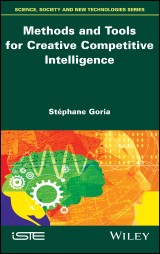Details

Methods and Tools for Creative Competitive Intelligence
1. Aufl.
|
139,99 € |
|
| Verlag: | Wiley |
| Format: | |
| Veröffentl.: | 26.05.2017 |
| ISBN/EAN: | 9781119427445 |
| Sprache: | englisch |
| Anzahl Seiten: | 272 |
DRM-geschütztes eBook, Sie benötigen z.B. Adobe Digital Editions und eine Adobe ID zum Lesen.
Beschreibungen
<p>"Creative competitive intelligence" is an information-seeking and monitoring activity of an information environment for the purpose of creativity and innovation. It involves the process leading up to the development of an informational supply adapted to the inspiration of creative or innovative personnel. </p> <p>This dynamic aims for the recognition of novelties (ideas, products, technologies, etc.), the identification of new players in the world of creation and innovation, and the identification of forgotten or neglected developmental paths.</p> <p>This book is aimed at readers who already have some experience of innovation and who are now looking for new ways to discover new products under development, anticipate the design of future products, identify unexplored tracks of inventions, develop and analyze innovation strategies, or recognize the emergence of budding artists.</p>
<p>Introduction ix</p> <p><b>Chapter 1 Intelligence and Creative Competitive Intelligence 1</b></p> <p>1.1 Supplying intelligence 1</p> <p>1.2 Informational supply and creative competitive intelligence 10</p> <p>1.3 Creative class and creative competitive intelligence 12</p> <p>1.4 Creative competitive intelligence, objectives and means 15</p> <p><b>Chapter 2 Researching and Identifying Trends 17</b></p> <p>2.1 Weak and strong signals and routine signals 17</p> <p>2.1.1 The puzzle method 19</p> <p>2.1.2 The 3S hypotheses method 19</p> <p>2.1.3 Researching routine signals 20</p> <p>2.2 Trends interpreted using graphs 21</p> <p>2.3 Sources of information on trends 27</p> <p>2.4 Algorithm of trend research 32</p> <p><b>Chapter 3 Formatting, Analysis and Inspiration Using Trends 37</b></p> <p>3.1 Word clouds 37</p> <p>3.2 Boards, cartograms and trend books 40</p> <p>3.3 Note about researching images that relate to a trend 44</p> <p>3.4 Trend funnel and cartogram of opportunities 48</p> <p>3.5 Routine boards 51</p> <p><b>Chapter 4 Presenting and Analyzing Networks 53</b></p> <p>4.1 Overview 53</p> <p>4.2 Illustrating indirect links 54</p> <p>4.3 Illustrating links between individuals 56</p> <p>4.4 Demonstrating networks with multivariate entities 60</p> <p>4.4.1 Using star glyphs 60</p> <p>4.4.2 Using Chernoff faces 61</p> <p>4.5 Invisible chessboards 64</p> <p>4.6 Comparative analysis of networks using graphs 66</p> <p><b>Chapter 5 Visual Tools for Problem Solving 67</b></p> <p>5.1 The great issues of problem solving 67</p> <p>5.2 Maps to express questions and ideas 68</p> <p>5.2.1 Mind maps 68</p> <p>5.2.2 Concept maps 69</p> <p>5.2.3 Lotus flower maps 72</p> <p>5.2.4 Ishikawa diagrams 74</p> <p>5.2.5 The tree to break down objectives 76</p> <p>5.3 Window tools to change perspective 77</p> <p>5.3.1 Crossing multiscreens 77</p> <p>5.3.2 Hyperspective multi-windows 79</p> <p>5.3.3 The customer experience corridor 80</p> <p>5.4 Business use cases and user stories 82</p> <p>5.4.1 Business use case diagrams 82</p> <p>5.4.2 User stories 84</p> <p>5.5 User experience maps 84</p> <p><b>Chapter 6 Investigating the Past and Present 87</b></p> <p>6.1 Existing solutions 87</p> <p>6.1.1 Go and see what is done in other regions 88</p> <p>6.1.2 Go to see what is done in other sectors 89</p> <p>6.1.3 Go and see what exists in nature 91</p> <p>6.2 Lateral thinking of obsolete technologies 94</p> <p>6.3 The C-K theory for design 96</p> <p>6.4 Investigating blue oceans 99</p> <p>6.4.1 Strategic canvas 100</p> <p>6.4.2 Forgotten customers 101</p> <p>6.5 Crossing of current trends 103</p> <p><b>Chapter 7 Inspiration Using TRIZ 107</b></p> <p>7.1 A few general points about TRIZ 107</p> <p>7.2 The innovation principles 108</p> <p>7.3 Matrix of (technical) contradictions 109</p> <p>7.4 Separation principles 112</p> <p>7.5 Eras and laws of technical system evolution 113</p> <p>7.6 Analyzing the technical system 117</p> <p>7.7 The ideal final result (IFR) 119</p> <p><b>Chapter 8 Reasoning with the Aid of Operators 121</b></p> <p>8.1 Search operators of expressions of avenues for innovation 121</p> <p>8.2 The easy choice operators and their negation 124</p> <p>8.3 Verbal operators 127</p> <p>8.3.1 Scamper 127</p> <p>8.3.2 Mathematical operators (the most basic ones) 128</p> <p>8.3.3 DTC operators 128</p> <p>8.3.4 FRED ASTAIRE operators 129</p> <p>8.4 Operators using the imaginary 130</p> <p>8.4.1 The operator using super powerful characters (SPC) 130</p> <p>8.4.2 The operator inspired from science fiction (ISF) 131</p> <p>8.5 Combined techniques 135</p> <p>8.5.1 The use of the Sequencer 135</p> <p>8.5.2 Crossing of windows and operators 136</p> <p>8.6 The analogical operators 138</p> <p>8.6.1 Simple usage of an analogy matrix 139</p> <p>8.6.2 Using Synectics 141</p> <p><b>Chapter 9 Use of Games for Serious Purposes 143</b></p> <p>9.1 Some forms of games 143</p> <p>9.1.1 A game as an attitude or support 144</p> <p>9.1.2 The game as a design goal 145</p> <p>9.2 The game for serious purposes 148</p> <p>9.3 Information bingo to monitor speeches 150</p> <p>9.4 The semantic brainball to find ideas 153</p> <p>9.5 Keyword battleships 155</p> <p><b>Chapter 10 Diversion of Role-playing Games 159</b></p> <p>10.1 Role-playing games 159</p> <p>10.2 Knowledge acquisition through role-playing 160</p> <p>10.3 The personas 160</p> <p>10.4 The court of ideas 164</p> <p>10.5 The seven creative families 168</p> <p>10.6 Investigation trees 169</p> <p>10.7 Complex route mapping 171</p> <p>10.8 The investigation of possible futures 172</p> <p><b>Chapter 11 Tactical or Strategic Reflection and Wargames 175</b></p> <p>11.1 Reasoning by military analogies 175</p> <p>11.2 Free business wargames 179</p> <p>11.3 Product clash maps 182</p> <p>11.3.1 Choice and preliminary data collection, development of questionnaires 182</p> <p>11.3.2 Drawing the bottom of the map/terrain 185</p> <p>11.3.3 Placing pawns and estimating movements: the simplified version 186</p> <p>11.3.4 Placing pawns and estimating movements: the detailed version 187</p> <p>11.3.5 Reasoning using product clash maps 189</p> <p>11.4 The strategic goban 189</p> <p><b>Chapter 12 Use of Objective-based Games 195</b></p> <p>12.1 A small point about games with a purpose 195</p> <p>12.2 The strategic and creative shoot (SCS) 196</p> <p>12.2.1 SCS, strategic round 197</p> <p>12.2.2 SCS, creative round 199</p> <p>12.2.3 SCS, counter-attack or second level 201</p> <p>12.3 The Rummy of attributes 203</p> <p>12.4 The Small Horse Challenge 205</p> <p>12.5 The informational and creative centipede 209</p> <p><b>Chapter 13 Creative Competitive Intelligence and Territorial Intelligence 215</b></p> <p>13.1 Territory in question 215</p> <p>13.2 Problems with creative competitive intelligence and territorial intelligence 217</p> <p>13.3 Geo-strategic approach 220</p> <p>13.4 Risk approach with Clue Storming 223</p> <p>Conclusion 229</p> <p>Bibliography 233</p> <p>Index 241</p>
<strong>Stéphane Goria</strong>, University of Lorraine, France.

















